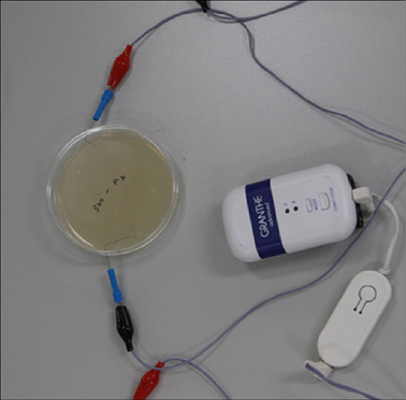Ann Dermatol.
2016 Oct;28(5):575-578. 10.5021/ad.2016.28.5.575.
Investigating Effects of Nano- to Micro-Ampere Alternating Current Stimulation on Trichophyton rubrum Growth
- Affiliations
-
- 1Department of Rehabilitation Medicine, Catholic University of Daegu School of Medicine, Daegu, Korea.
- 2Department of Dermatology, Catholic University of Daegu School of Medicine, Daegu, Korea. g9563009@cu.ac.kr
- 3Department of Pathology, Catholic University of Daegu School of Medicine, Daegu, Korea.
- KMID: 2382881
- DOI: http://doi.org/10.5021/ad.2016.28.5.575
Abstract
- BACKGROUND
Fungi are eukaryotic microorganisms including yeast and molds. Many studies have focused on modifying bacterial growth, but few on fungal growth. Microcurrent electricity may stimulate fungal growth.
OBJECTIVE
This study aims to investigate effects of microcurrent electric stimulation on Trichophyton rubrum growth.
METHODS
Standard-sized inoculums of T. rubrum derived from a spore suspension were applied to potato dextrose cornmeal agar (PDACC) plates, gently withdrawn with a sterile pipette, and were applied to twelve PDACC plates with a sterile spreader. Twelve Petri dishes were divided into four groups. The given amperage of electric current was 500 nA, 2 µA, and 4 µA in groups A, B, and C, respectively. No electric current was given in group D.
RESULTS
In the first 48 hours, colonies only appeared in groups A and B (500 nA and 2 µA exposure). Colonies in group A (500 nA) were denser. Group C (4 µA) plates showed a barely visible film of fungus after 96 hours of incubation. Fungal growth became visible after 144 hours in the control group.
CONCLUSION
Lower intensities of electric current caused faster fungal growth within the amperage range used in this study. Based on these results, further studies with a larger sample size, various fungal species, and various intensities of electric stimulation should be conducted.
MeSH Terms
Figure
Reference
-
1. Pommerville JC. Alcamo's fundamentals of microbiology. 9th ed. Sudbury, MA: Jones and Bartlett Publishers;2010.2. Tampieri MP. Update on the diagnosis of dermatomycosis. Parassitologia. 2004; 46:183–186.3. Lusiana , Reichl S, Müller-Goymann CC. Infected nail plate model made of human hair keratin for evaluating the efficacy of different topical antifungal formulations against Trichophyton rubrum in vitro. Eur J Pharm Biopharm. 2013; 84:599–605.
Article4. Kim KS, Kim JW, Kye YC, Kim SN. A caes of tinea capitis in an adult due to trichophyton rubrum. Ann Dermatol. 2000; 12:189–192.
Article5. Gentles JC. Laboratory investigations of dermatophyte infections of nails. Sabouraudia. 1971; 9:149–152.
Article6. Hong SH, Jeong J, Shim S, Kang H, Kwon S, Ahn KH, et al. Effect of electric currents on bacterial detachment and inactivation. Biotechnol Bioeng. 2008; 100:379–386.
Article7. Cheng N, Van Hoof H, Bockx E, Hoogmartens MJ, Mulier JC, De Dijcker FJ, et al. The effects of electric currents on ATP generation, protein synthesis, and membrane transport of rat skin. Clin Orthop Relat Res. 1982; (171):264–272.8. Mitchell P. Chemiosmotic coupling in oxidative and photosynthetic phosphorylation. Biol Rev Camb Philos Soc. 1966; 41:445–502.
Article9. Mitchell P. Vectorial chemistry and the molecular mechanics of chemiosmotic coupling: power transmission by proticity. Biochem Soc Trans. 1976; 4:399–430.
Article10. Kaziro Y. The role of guanosine 5'-triphosphate in polypeptide chain elongation. Biochim Biophys Acta. 1978; 505:95–127.
Article11. Keller EB, Zamecnik PC. The effects of guanosine diphosphate and triphosphate on the incorporation of labeled amino acids into protiens. J Biol Chem. 1956; 221:45–60.12. Hubel KA. The effects of electrical field stimulation and tetrodotoxin on ion transport by the isolated rabbit ileum. J Clin Invest. 1978; 62:1039–1047.
Article13. Kalinowski DP, Edsberg LE, Hewson RA, Johnson RH, Brogan MS. Low-voltage direct current as a fungicidal agent for treating onychomycosis. J Am Podiatr Med Assoc. 2004; 94:565–572.
Article14. Bozoky L, Kiszely G, Hoffmann TA, Ladik J. Effect of electrostatic fields on cell mitosis. Nature. 1963; 199:1306.
Article
- Full Text Links
- Actions
-
Cited
- CITED
-
- Close
- Share
- Similar articles
-
- Stimulatory and Inhibitory Effects of Alternating Current on the Growth of Trichophyton rubrum
- In vitro Antifungal Activity of Limonene against Trichophyton rubrum
- A Case of Melanonychia Caused by Trichophyton rubrum
- A Caes of Tinea Capitis in an Adult Due to Trichophyton Rubrum
- Isolation of Trichophyton rubrum from Diabetic Foot Ulcers of 4 Patients



